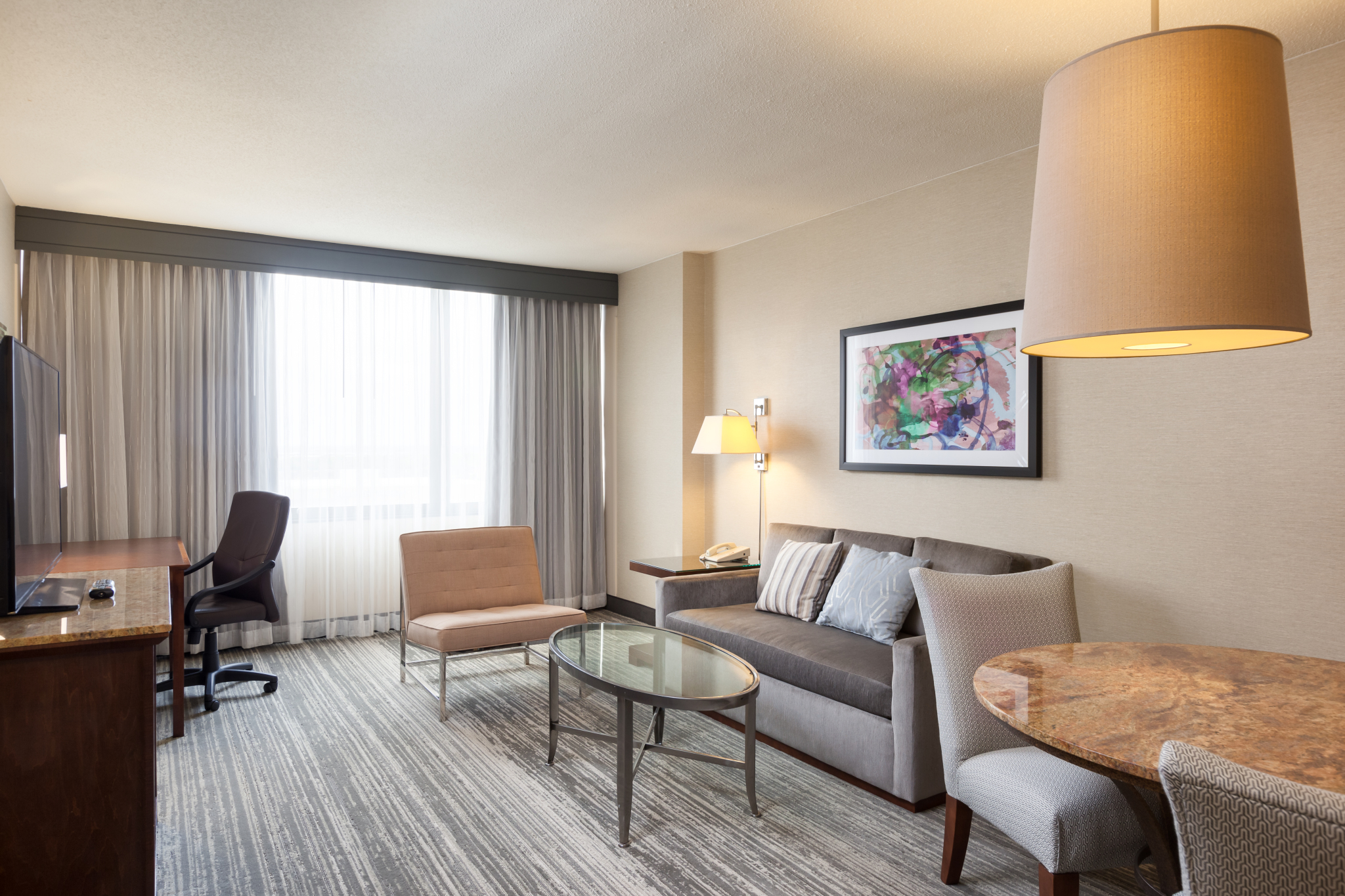Traditionally, guestrooms have been designed in one of two ways: A room with a king-size bed will cater to solo business travelers during the week, while families tend to prefer a room with two queen beds on the weekends.
This, of course, means that some rooms have traditionally gone unused at one part of the week or another—until now. Hotels are increasingly adding adjustable seating that folds out to king rooms so that the same space can cater to a single traveler during the week and a family Friday through Sunday.
“It is easier for a hotel to sell a king room with a sleeper sofa as it provides the greatest flexibility,” said Lisa Haude, president of Paradigm Design Group. “Rooms today sometimes have to fulfill multiple purposes and hotels have to be flexible to accommodate them. Manufacturers are being challenged to create better mechanisms so the sofas are easier to set up and comfortable to sleep on, yet also accommodate the high-end residential feel of the guestroom.”
In late 2015, IHG announced a new design scheme for its Holiday Inn hotels that included a king bed and a chaise lounge with a hidden trundle bed, allowing as many as four guests to sleep in the room as needed. “For owners, the goal was to offer a room solution that meets the needs of both the business traveler and leisure traveler, thus making the room flex throughout the week, helping lead to more profitability,” said Eric Lent, VP of Holiday Inn and Crowne Plaza brands, Americas, for IHG.
“It used to be that no one wanted to sleep on the pull-out sofa. Now, there are several companies [that] have improved the experience by incorporating thicker mattresses, easier setup and the removal of the dreaded bar. The goal now is to not just make the sleeper sofa where the kids sleep, but a useful element to have in rooms for adults as well.” — Lisa Haude, president of Paradigm Design Group
imilarly, in its suites, the midscale La Quinta brand’s new Del Sol prototype has a sectional sofa that folds out into a bed, which Raj Trivedi, EVP of franchise at La Quinta Properties, said offers a “more personalized” space for travelers. “They can relate to it more like they do at home,” he said. The brand’s previous design prototypes had a smaller sofa and two chairs in its suites, but as Krishna Paliwal, SVP of design and development for La Quinta, pointed out, the cost of that furniture was higher than the cost of the sectional fold-out sofa bed, offering an additional appeal for franchise owners.
The suite design plan also includes a C-shaped table that can be moved aside easily when the sofa becomes a bed, and can serve as a nightstand for anyone sleeping on the sofa bed.
While the Holiday Inn “King Comfort Hideaway” design plan is not a required room type as part of Holiday Inn’s new H4 guestroom design, Lent said that IHG has seen “significant interest” from owners. “Our very first H4 property recently opened with this room type, and we currently have six additional ‘early adopter’ hotels in the pipeline planning to include the room type,” he said.
The Right Furniture for the Right Room
With adjustable seating, the options are only as limited as the square footage available in the guestroom—but some choices are more popular than others. “There’s been a push for smaller pieces that can fold out without taking up much space,” Haude said. “We have also been incorporating more chaise-like chairs and sofas with a larger C-type table that can be used for eating or working in lieu of the standard lounge chair and ottoman combo.”

Judi Kieffer, president of Kieffer Design Group, said that her company has designed a sofa/trundle bed combo that uses a standard twin mattress. “The trundle portion glides out on wheels with the mattress encased within a box, with easy-to-change standard sheets, and it locks for safety,” she said. Kieffer has also recently designed a sofa/chaise lounge combo in a family suite that also was requested for executive business use.
Sofa beds are a classic option, and are much more comfortable than the bulky models of years past, which often had thin mattresses that barely covered the bed’s rails. “The selection shouldn’t make you feel like you’re sleeping on a railroad track,” Kieffer said, and recommended American Leather products, which she said “have a very comfortable mattress” and can be switched from sofa to bed with a single hand.
The sofa beds in La Quinta’s Del Sol prototype are also designed to be easily adaptable. “You don’t have to move many things to turn it into a bed,” Trivedi said, noting that guests will want to come back to a room that they can configure with minimal physical effort.
A recliner, Kieffer said, is also a good solution for Americans with Disabilities Act-compliant guestrooms or rooms where the guest needs to sleep in a more upright position. “There are some important requirements in the selection,” she said, and suggested that designers look for recliners that that do not swivel, that have short legs, automatic adjustments instead of a lever and leather (“or quality leather-like material”) for easy cleaning. “This option doesn’t really take up any more room than a large lounger with an ottoman, but gives more comfort and flexible options for guests,” she said. “It’s a nice bonus when the guest finds out they can be offered special amenities for their requirements.”
Ultimately, Haude said, a hotel should choose its adjustable seating based on its target demographic. “A leisure destination may want more adjoining rooms and king bed/sleeper sofa combinations, while a hotel that hosts a lot of school or sport groups may want more double queen configurations,” she said.
